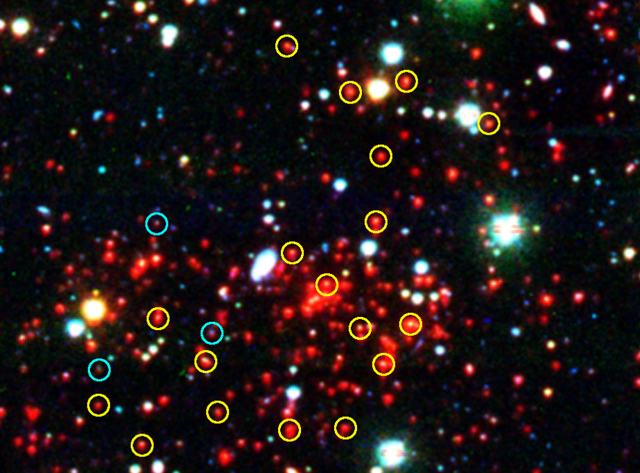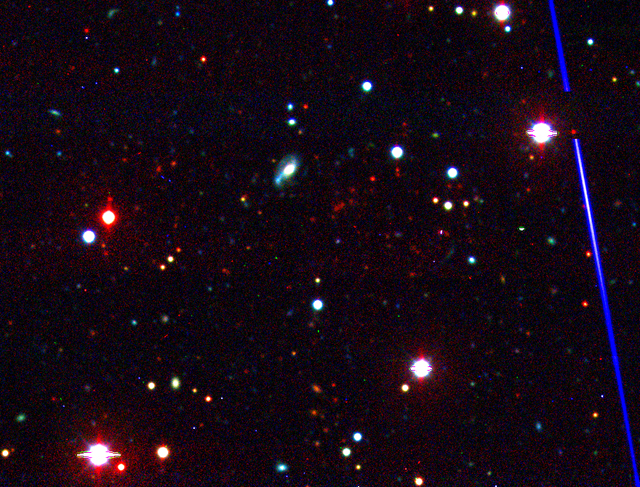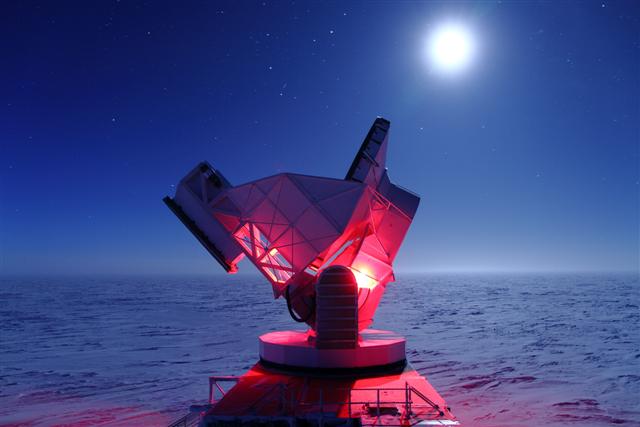Heavyweight discoverySouth Pole Telescope finds most massive galaxy cluster to datePosted October 22, 2010
Astronomers using the South Pole Telescope “This galaxy cluster wins the heavyweight title. It’s among the most massive clusters ever found at this distance,” said Mark Brodwin Brodwin is first author on the paper announcing the discovery, which appeared in a recent edition of the Astrophysical Journal. John Carlstrom The cluster (designated SPT-CL J0546-5345) is 7 billion light-years away, meaning scientists see it as it appeared 7 billion years ago, when the universe was half as old as now and the Earth and its solar system didn’t exist yet. Since then, the heavyweight cluster should have grown about four times larger, making it one of the most massive galaxy clusters in the universe. 
Photo Credit: Infrared Image: NASA/JPL-Caltech/M. Brodwin (Harvard-Smithsonian CfA) Optical Image: CTIO Blanco 4-m telescope/J. Mohr (LMU Munich)
An infrared/optical representative-color image of a massive galaxy cluster located 7 billion light-years from Earth. Galaxies with "old" stellar populations, like modern-day ellipticals, are circled in yellow; galaxies with "young" stellar populations, like modern-day spirals, are circled in blue.

Photo Credit: CTIO Blanco 4-m telescope/J. Mohr (LMU Munich)
This optical image of the newfound galaxy cluster highlights how faint and reddened these galaxies are due to their great distance. The cluster remained hidden until the South Pole Telescope spotted it by looking for distortions in the cosmic microwave background. The blue streak is a satellite passing through the field of view during the timed exposure.
“This cluster is full of ‘old’ galaxies, meaning that it had to come together very early in the universe’s history — within the first two billion years,” Brodwin said. Galaxy clusters like this can be used to study how dark matter and dark energy Long ago, when the universe was smaller and more compact, gravity had a greater influence. It was easier for galaxy clusters to grow, especially in areas that were already more than their surroundings. As the universe expanded at an accelerating rate due to dark energy, it grew more diffuse. Dark energy now dominates over the pull of gravity and chokes off the formation of new galaxy clusters. Brodwin and his colleagues spotted their quarry in data collected from the new SPT, which is currently completing its pioneering millimeter-wave survey of a huge swath of sky covering 2,500-square degrees. The main goal of the SPT survey is to find a large sample of massive galaxy clusters in order to learn more about dark energy. Additional goals include understanding the evolution of hot gas within galaxy clusters, studying the evolution of massive galaxies in clusters, and identifying distant, rapidly star-forming galaxies. The SPT hunting technique for giant galaxy clusters uses the Sunyaev-Zel’dovich (SZ) effect Once this distant cluster was found, the team studied it with the Infrared Array Camera The team expects to find many more giant galaxy clusters lurking in the distance once the South Pole Telescope survey is completed. “After many years of effort, these early successes are very exciting. The full SPT survey, to be completed next year, will rewrite the book on the most massive clusters in the early universe,” Brodwin said. NSF-funded research in this story: John Carlstrom, John Ruhl, Joseph Mohr, William Holzapfel and Nils Halverson, University of Chicago, Award No. 0638937
|



For USAP Participants |
For The Public |
For Researchers and EducatorsContact UsNational Science FoundationOffice of Polar Programs Geosciences Directorate 2415 Eisenhower Avenue, Suite W7100 Alexandria, VA 22314 Sign up for the NSF Office of Polar Programs newsletter and events. Feedback Form |


